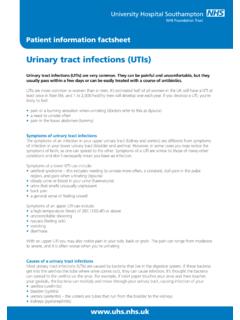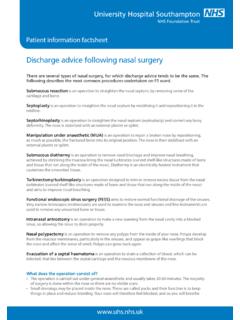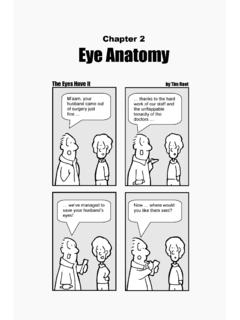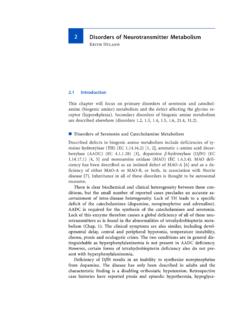Transcription of Ptosis surgery - patient information - UHS
1 patient information factsheet Ptosis What is Ptosis ? Ptosis (pronounced toe sys) is a droopy upper eyelid. The upper lid is lifted up by the levator muscle, which is attached to the lid by a tendon called the aponeurosis. What causes Ptosis ? The commonest cause for Ptosis in adults is gradual, age-related stretching of the aponeurosis tendon known as involutional Ptosis . The levator muscle itself is not affected and so the movement of the eyelid from looking up to down remains normal. Long term contact lens wear can cause Ptosis , perhaps because repeated insertion and removal of the lens causes stretching of the tissues. Sometimes Ptosis follows other eye surgery or an injury. The lid may droop due a problem in the nerve supply to the levator muscle Congenital Ptosis (present since birth) is usually due to a poorly developed levator muscle What are the effects of Ptosis ?
2 The upper lid droops. There may be difficulty with seeing, or discomfort and headache, especially towards the end of the day. The brow may be raised in an effort to keep the lid lifted or the head may be tipped back in order to see under the droopy lid(s). One or both lids may be affected. What is the treatment for Ptosis ? Mild Ptosis may not require treatment. If more severe, surgery may be helpful. The surgeon needs to check that the eyes are generally healthy since Ptosis surgery may not be advisable in some eye diseases. There are several operations used to treat Ptosis . Aponeurosis advancement The operation is performed through an incision in the natural skin crease of the eyelid. The aponeurosis tendon is tightened with stitches and the wound closed.
3 The results of surgery are better when it is performed under local anaesthetic because when you are awake during the operation you can open your eyes when asked, to allow the surgeon to judge the best position for your eyelids. Generally all the stitches are absorbable and will drop out by themselves after several weeks. Levator resection This operation is used when the levator function is not normal, particularly in children with congenital Ptosis . The levator muscle is tightened with stitches in a similar way to the tendon tightening in aponeurosis advancement Muller s muscle resection This operation is performed through an incision on the inside of the eyelid. A layer of muscle called Muller s muscle is shortened and tightened using three stitches, which need to be removed up to three weeks after surgery .
4 This operation is generally only performed on patients who, in clinic, have shown a positive response to an eye drop test. Fasanella-Servat procedure This operation is very occasionally used to correct small amounts of Ptosis and is performed through an incision on the inside of the eyelid. Brow suspension This operation is used to correct Ptosis when the levator muscle is very weak. The forehead muscle (frontalis) is used to help lift the eyelid by placing a sling of material which is burrowed under the skin, between the forehead and the eyelid. The material can either be taken from the patient eg. the tendon in the outer thigh, or a synthetic material can be used such as silicone cord. What are the aims of surgery ?
5 The surgery aims to lift the eyelid enough to stop the Ptosis causing problems with vision. The ideal result is when: 1. The lid sits at a normal level. 2. The level matches the level of the other lid. 3. The lid has a natural curve or contour, which matches the other lid. 4. The eye closes fully and is comfortable. What happens at Ptosis surgery ? In adults the surgery is generally done as a day case procedure under local anaesthetic. Sometimes a small amount of sedation is given prior to the local anaesthetic. Occasionally the surgery is done under general anaesthetic. The operation is done in the operating theatre. You will lie on a couch and numbing drops put in your eyes. The skin is cleaned with antiseptic and drapes are wrapped around your head.
6 Marks are drawn on the eyelid skin with washable ink and then local anaesthetic injections are given to numb the eyelid, which sting for a short while. For aponeurosis advancement a cut is made in the skin crease of the lid and the levator tendon is found. The tendon is tightened with temporary stitches. The lights are then dimmed and you will be asked to open your eyes to see whether the stitches are in the correct position and, if necessary, they can be adjusted. Once the stitches are correctly placed the skin is closed with dissolving stitches. The wound is placed in the natural skin crease of the lid so that it is generally doesn t show once it has healed. A pad is then put on the operated eye. For Muller s muscle resection a cut is made on the inside of the upper lid and the muscle shortened using non dissolving stitches which lie on the natural skin crease of the lid.
7 The stitches are removed between one and three weeks after the surgery . The surgery takes about 45 to 60 minutes per eye. If both eyes have Ptosis it is usually best to operate on both sides at the same time to give the best chance of a symmetrical result. What happens after the operation? If both upper lids have been treated, at least one of the eye pads will be removed after an hour and you can then return home to rest. Any remaining eye pad should be removed the next day. You will usually need about one week off work and a few days off driving after the operation and should ask staff for a certificate, if required. You will be given drops and ointment to use and a clinic appointment will be made for a check up about a week later.
8 What are the benefits of Ptosis surgery ? An enlargement of the upper part of your field of vision An improvement in the quality of vision, especially the brightness of vision, where part of the eye was previously covered by the drooping upper lid Restoring the normal appearance of the lid Improving symmetry with the other eyelid What are the risks of Ptosis surgery ? The risks of surgery include, but are not limited to: Bruising and swelling of the eyelids. The lid may feel sore and look bruised and swollen for up to a few weeks. There is a very small risk of orbital haemorrhage with potential permanent visual loss Wound infection. There is a small risk of infection following surgery , which would need treatment with antibiotic tablets.
9 Overcorrection The eyelid is too high after the operation and the eye might then become sore and dry. Drops and ointment may help the comfort. Massage and traction on the lid may cure a mild amount of overcorrection. Occasionally a further operation to lower the eyelid is required soon after the initial operation. Under correction The eyelid is still low after the surgery . Poor contour The curve of the upper lid is not correct Incomplete lid closure. The lids may not close fully with the eye slightly open at night. There is a risk of the front surface of the eye becoming dry and uncomfortable. Drops and ointment may correct this but occasionally further surgery is required Scarring Temporary patches of numbness of the eyelid Reoperation Further surgery is required in a small percentage of cases In addition to the risks specific to the individual procedure, there are also general risks, such as blood loss, infection, cardiac arrest, airway problems and blood clots, which are associated with any surgical procedure.
10 Local anaesthetic may cause bruising or possible allergic responses. In 2006 a National Audit of aponeurosis advancement Ptosis surgery by the British Oculoplastics Surgical Society (BOPSS) showed the following results: Complete success Lid at desired level Partial success Lid better than before surgery but not perfect Failure Further surgery required What is congenital Ptosis ? This is drooping of one or both eyelids, present since birth. It is generally due to the levator muscle, which opens the lid, not developing properly and being weak. Children with congenital Ptosis may also have a squint (when an eye turns inwards or outwards), may need glasses to correct short or long-sightedness and may be at risk of having a lazy eye (amblyopia) when the vision does not develop normally in that eye.

















